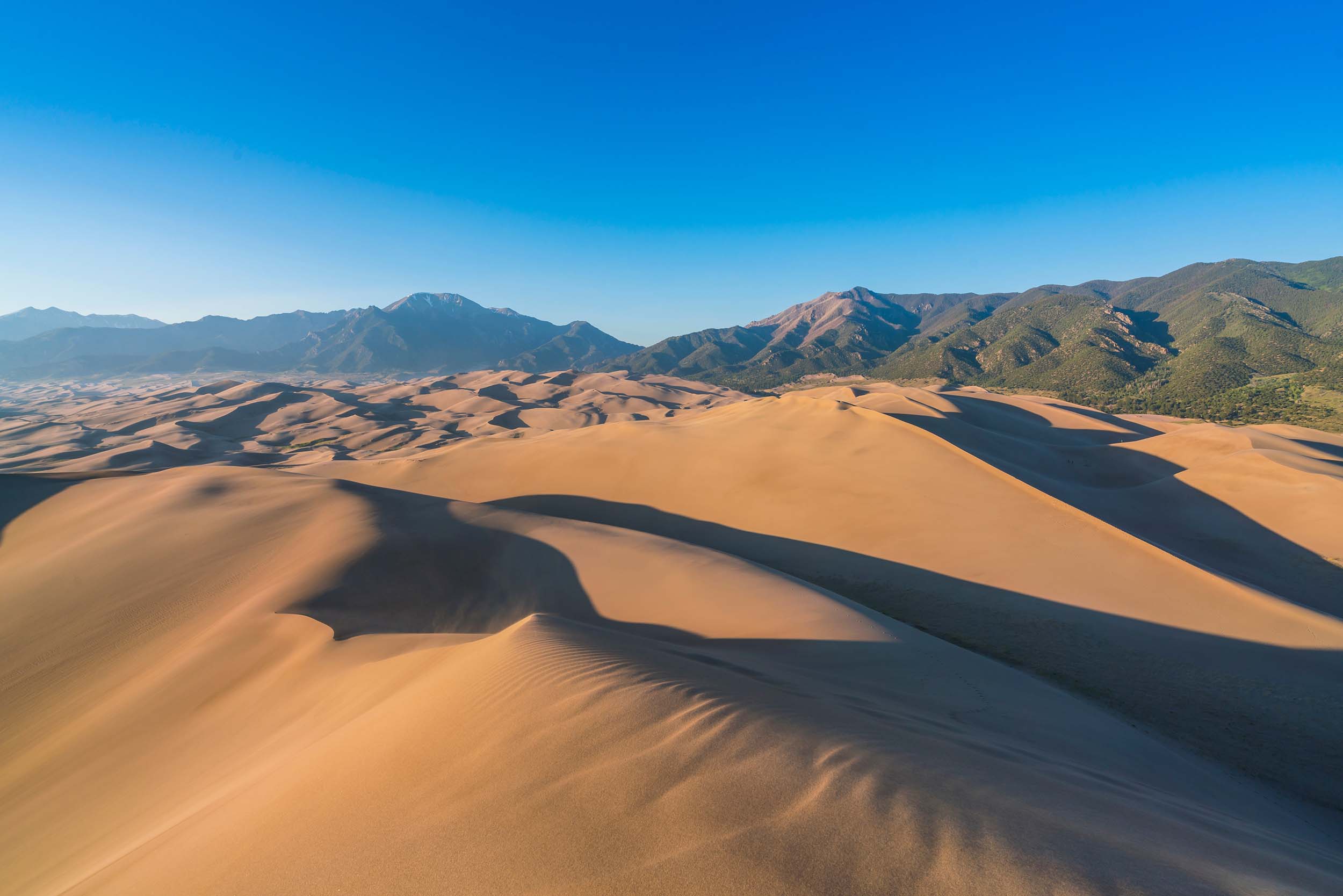Park Information Quick Facts
Location: Colorado
Park Size: 150, 000 Acres
Time Needed:1-2 days
Best Season: September and October
Must Do: High Dune
Pro Tips: Plan your visit early in the morning or late in the evening to avoid the intense midday heat on the sand, which can reach temperatures of 150°F (65°C) during summer.
Visitor Centers
The Great Sand Dunes Visitor Center serves as the primary hub for visitors, located near the park entrance. It offers breathtaking views of the towering dunes and the surrounding Sangre de Cristo Mountains, providing an excellent starting point for your exploration. Inside, you’ll find exhibits that showcase the park’s unique geology, ecosystems, and cultural history. Interactive displays help visitors understand the formation of the dunes and the role of wind and water in shaping this remarkable landscape. The center also features a park film, ranger-led programs, and a gift shop with souvenirs and educational materials. Staff at the information desk are available to answer questions, provide maps, and assist with trip planning.
Plan Your Great Sand Dunes Adventure Today!
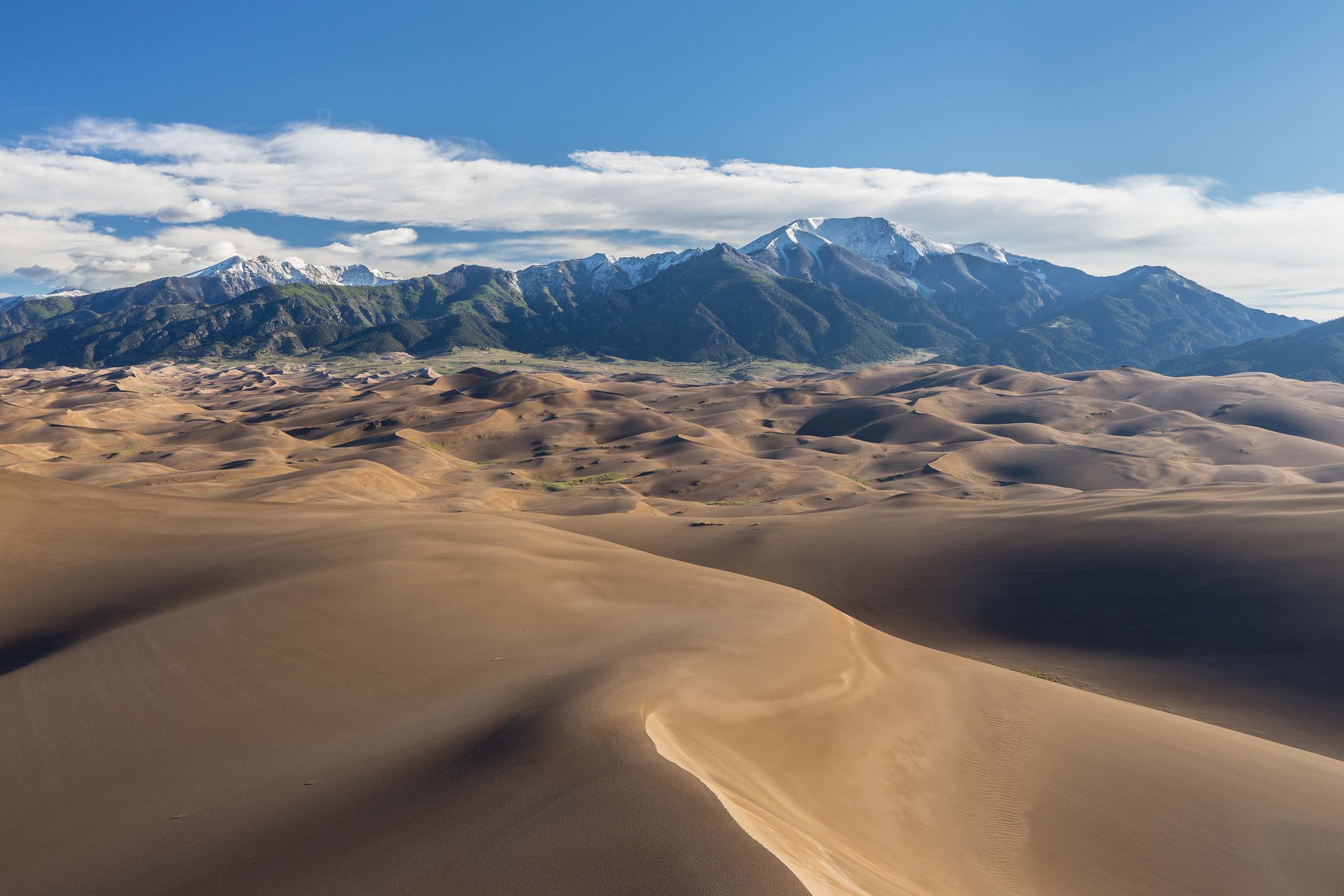
Getting There
How to Travel to Great Sand Dunes National Park
Traveling to Great Sand Dunes National Park requires some planning due to its remote location in southern Colorado. The nearest major airport is Colorado Springs Airport, about 2.5 hours away by car. Denver International Airport, a larger hub, is approximately 4 hours away. From either airport, you can rent a car and enjoy a scenic drive through Colorado’s diverse landscapes. The park is most accessible via U.S. Highway 160 and Colorado Highway 150, with clear signage leading to the entrance. Ensure your vehicle is in good condition, especially if you plan to explore Medano Pass Primitive Road, which requires a high-clearance 4WD vehicle.
Public transportation options to the park are limited, making a private vehicle the best choice for flexibility. If you’re traveling by train or bus, the nearest stations are in Alamosa, about 30 miles west of the park. From there, car rentals or rideshare services can help you reach the park. Visitors traveling via RV should note that parking and camping are available but may be limited during peak seasons. Be sure to check road conditions, especially in winter, as snow and ice can impact access routes.
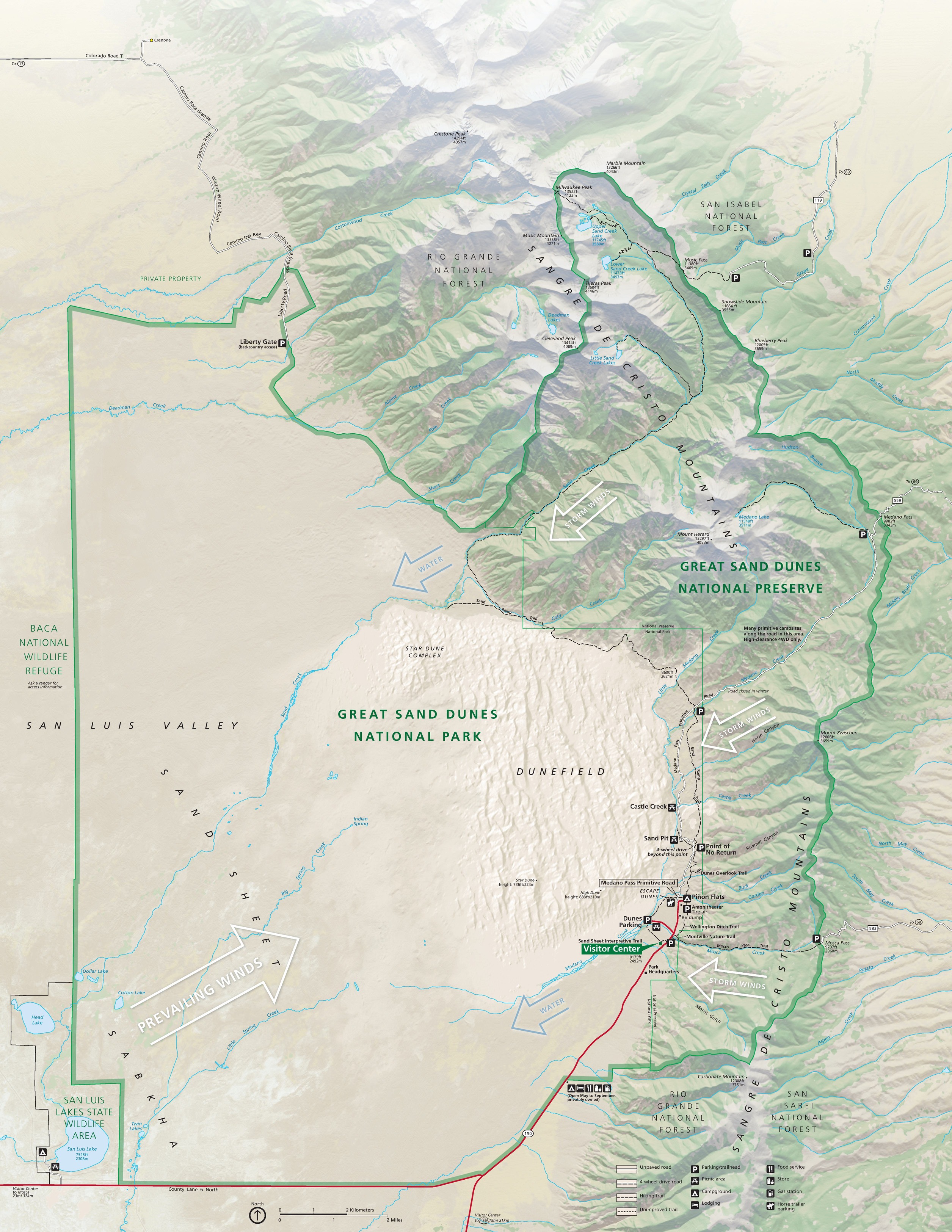
Camping
Piñon Flats Campground
- Location: Inside the park, near the visitor center.
- Details:
- 88 sites for tents, trailers, and RVs (up to 25 feet).
- Each site has a picnic table, fire grate, and bear-proof food locker.
- Amenities include potable water and restrooms; no hookups or showers.
- Open seasonally from April to October.
Dunes Backcountry Camping
- Location: Beyond the first high ridge of the dunes (~1.5 miles from Medano Creek).
- Details:
- No designated sites; campers must set up beyond the first high ridge.
- No water or facilities; campers must pack in and pack out all supplies.
- A free backcountry permit is required, available at the visitor center.
Sand Ramp Trail Campsites
- Location: Along the Sand Ramp Trail, on the park’s eastern edge.
- Details:
- Seven designated primitive campsites.
- No facilities; campers must carry in all supplies.
- A free backcountry permit is required.
Medano Pass Primitive Road Campsites
- Location: Accessible via Medano Pass Primitive Road, which requires a high-clearance 4WD vehicle.
- Details:
- 21 numbered campsites available on a first-come, first-served basis.
- Each site includes a fire ring and bear-proof storage.
- No water or restrooms.
- Free permits are required, obtainable at the visitor center.
Nearby Campgrounds
- Oasis Campground: Just outside the park, with tent and RV sites, full hookups, and camping cabins. Amenities include showers, a store, and a restaurant.
- Zapata Falls Campground: 11 miles south of the park, offering primitive camping with pit toilets and no water.
- San Luis Lakes State Wildlife Area: About 15 miles west of the park, with first-come, first-served sites and electric hookups (requires a Colorado wildlife pass or license).
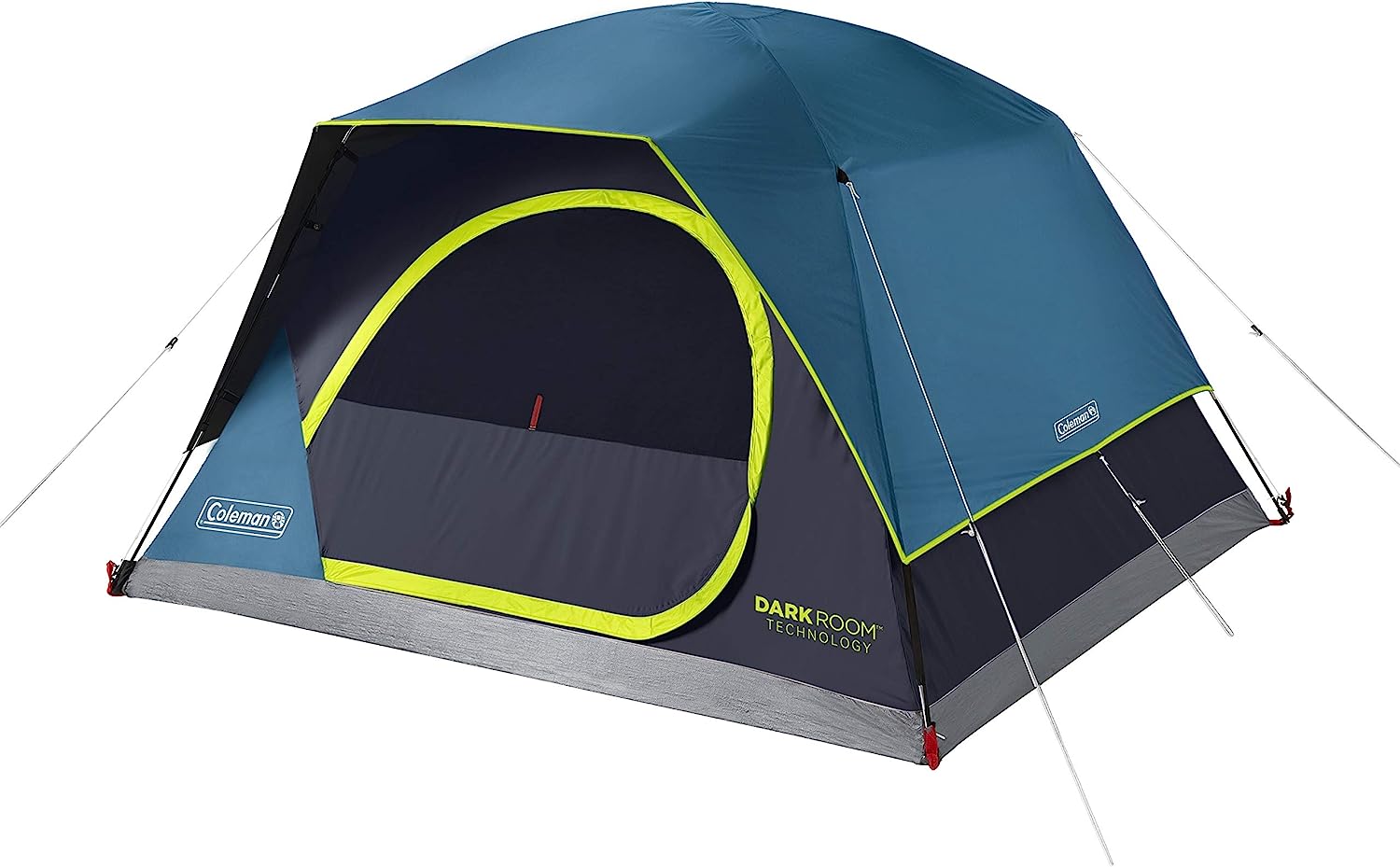

-
Prepare for Extreme Temperature Changes: The temperature at Great Sand Dunes can fluctuate drastically, especially between day and night. During summer, daytime temperatures on the dunes can exceed 100°F (38°C), while nighttime temperatures can drop to near freezing. Be sure to pack layers, including warm clothing for the evening, and bring plenty of water to stay hydrated during the heat of the day.
-
Use a 4WD for Rugged Roads: If you’re planning to camp along the Medano Pass Primitive Road or access more remote campsites, a high-clearance 4WD vehicle is essential. The road is rough and often requires a vehicle with good clearance to navigate safely. Check current road conditions before your trip, as the road may be impassable during or after heavy rainfall.
-
Watch for Wildlife and Secure Food: Bears and other wildlife are present in the park, so always store food properly. Use the provided bear-proof food lockers or hang food away from your campsite to keep it secure. It’s also a good idea to keep a clean camp by disposing of trash and food scraps promptly to avoid attracting animals.
Popular Hiking Trails
Dunes Overlook Trail
- Distance: 1.5 miles (round trip)
- Difficulty: Easy
- Details:
- This short trail offers panoramic views of the sand dunes and the surrounding valley.
- It’s a great option for those who want a quick hike with stunning views but prefer not to venture too far into the dunes.
Medano Creek Trail
- Distance: Varies (depending on water levels, usually a short walk)
- Difficulty: Easy
- Details:
- This trail follows Medano Creek, which runs along the base of the dunes during the spring and early summer.
- It’s an excellent option for a peaceful stroll, especially when the creek is flowing.
Mosca Pass Trail
- Distance: 6 miles (one-way)
- Difficulty: Moderate
- Details:
- This trail takes you through forested areas and climbs to Mosca Pass at an elevation of 9,000 feet.
- It offers a cool contrast to the hot dunes, with beautiful views of the San Luis Valley and diverse wildlife along the way.
Zapata Falls Trail
- Distance: 1.2 miles (round trip)
- Difficulty: Easy to Moderate
- Details:
- This trail leads to Zapata Falls, a stunning waterfall located just outside the park.
- The hike includes some rocky terrain and is especially beautiful when the falls are flowing, typically in spring and early summer.
Sand Dune Boardwalk Trail
- Distance: 0.5 miles (round trip)
- Difficulty: Easy
- Details:
- A boardwalk trail that leads to a viewpoint overlooking the dunes and the grasslands.
- Perfect for a short, accessible hike with beautiful views, especially for those with mobility challenges.
Siyeh Pass Trail
- Length: 10.3 miles (one way)
- Elevation Gain: 2,000 feet
- Difficulty: Strenuous
- Details: A long, challenging trail that offers stunning panoramic views of the park.
High Dune Trail
- Distance: 3 miles (round trip)
- Difficulty: Moderate to Strenuous
- Details:
- One of the most popular trails in the park, leading to the top of High Dune.
- The hike involves traversing the sand, which can be challenging, but the reward is a breathtaking view of the entire dune field and surrounding landscapes.
Sand Ramp Trail
- Distance: 4 miles (one-way)
- Difficulty: Moderate
- Details:
- This trail starts at the base of the dunes and leads to a ridge offering fantastic views of the dunes, as well as access to backcountry campsites.
- It’s a good choice for those looking for a more rugged hike with some elevation gain.
Hiking Trails in Great Sand Dunes National Park
Hiking at Great Sand Dunes National Park offers a truly unique experience, combining the challenge of trekking across vast sand dunes with the beauty of the surrounding landscapes. The park’s trails range from easy, accessible walks to more strenuous routes that climb the dunes or lead into the mountainous terrain. A hike to the top of High Dune is one of the most popular and rewarding trails, offering a panoramic view of the entire dune field, the San Luis Valley, and the distant Sangre de Cristo Mountains. This 3-mile round-trip trail is moderately difficult due to the soft sand, making it both a physical challenge and a visual delight.
For those looking for a more leisurely stroll, the Sand Dune Boardwalk Trail provides an easy half-mile walk that leads to an overlook with stunning views of the dunes and surrounding grasslands. It’s an excellent choice for families, individuals with limited mobility, or anyone wanting to take in the park’s beauty without exerting too much energy. Similarly, the Medano Creek Trail offers a peaceful, short walk along the creek, which flows at the base of the dunes during the spring and early summer. This trail is especially pleasant when the creek is running, providing a refreshing way to cool off on a warm day.
Wildlife at the Park
Great Sand Dunes National Park is home to a diverse array of wildlife, making it an excellent destination for nature enthusiasts. The park’s varying ecosystems, which include sand dunes, grasslands, wetlands, and forests, support a rich variety of species. In the sand dunes and surrounding grasslands, visitors can encounter a range of mammals such as pronghorn antelope, coyotes, mule deer, and the elusive mountain lion. These animals often roam the park in search of food and water, with pronghorn being particularly visible in the open grasslands. Small mammals like foxes, rabbits, and prairie dogs also inhabit the area, creating a dynamic food web that attracts various predators.
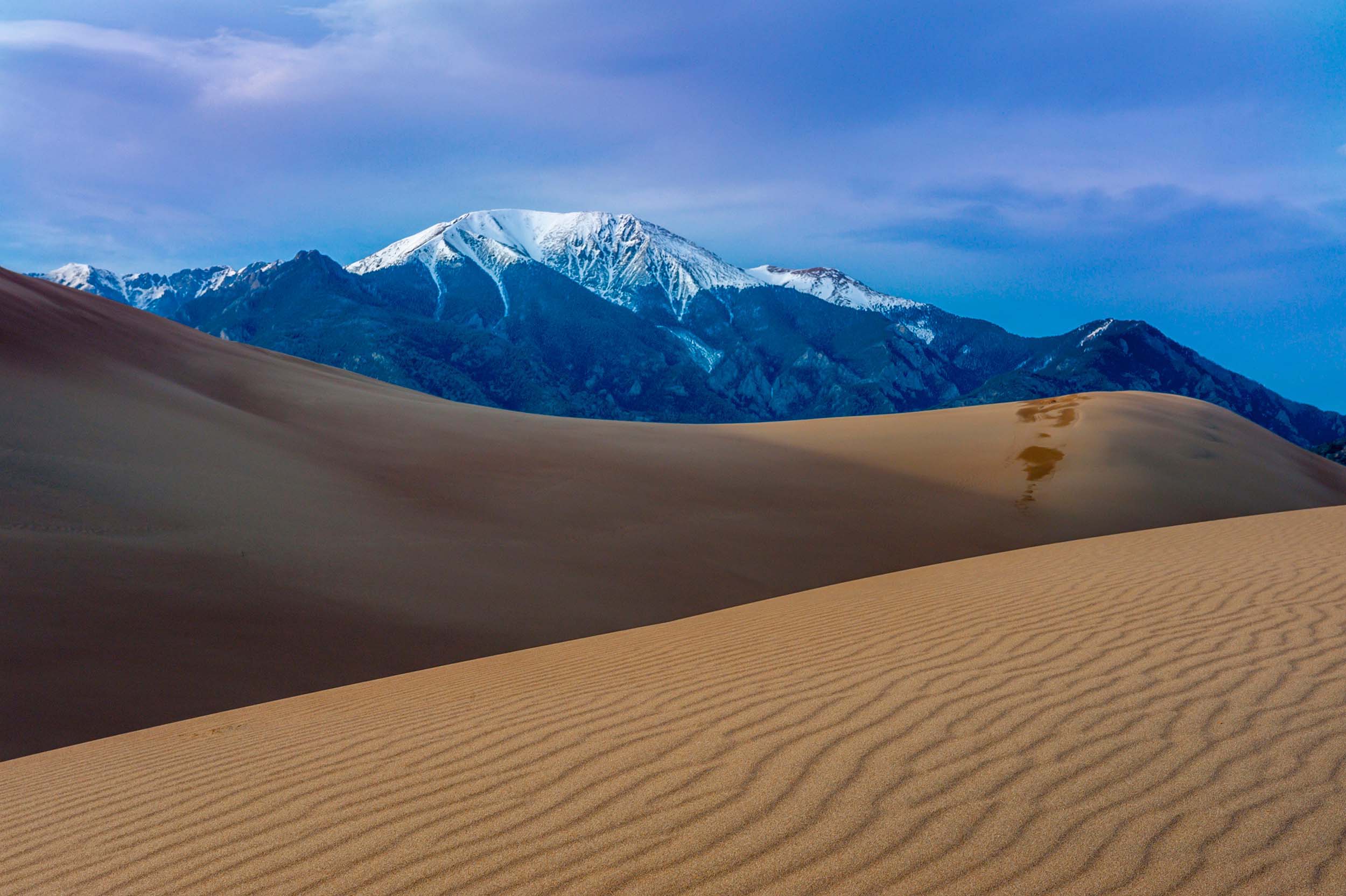
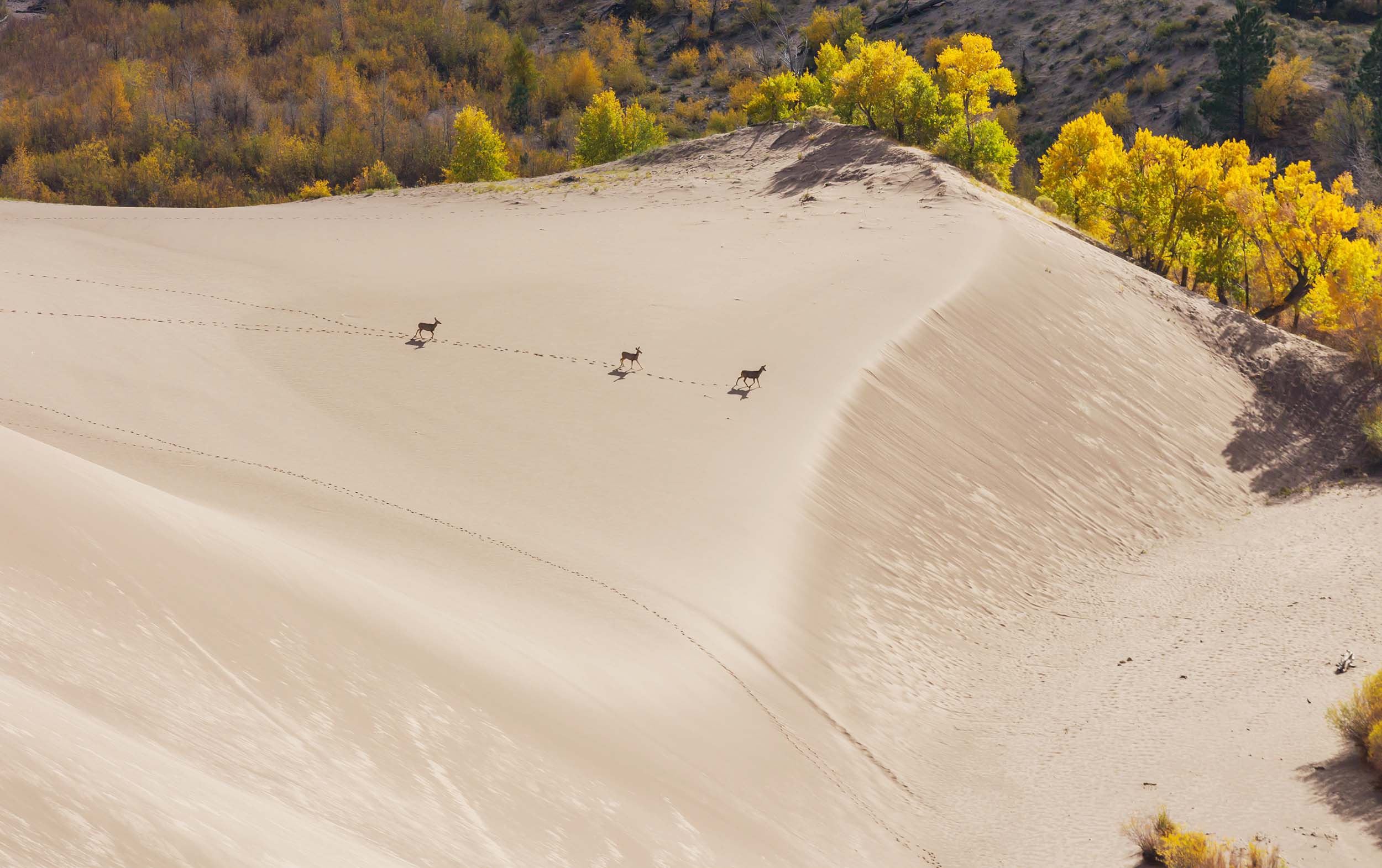
The wetlands at Great Sand Dunes, particularly the seasonal Medano Creek, serve as vital habitats for a variety of bird species. Waterfowl, such as ducks and geese, can be seen in the spring and fall as they migrate through the park. Sandhill cranes are another notable bird species that pass through the park during migration, making the park an important stopover for these large birds. Birdwatchers can also spot a variety of raptors, including red-tailed hawks and peregrine falcons, which nest in the surrounding cliffs and use the open areas for hunting small mammals and birds.
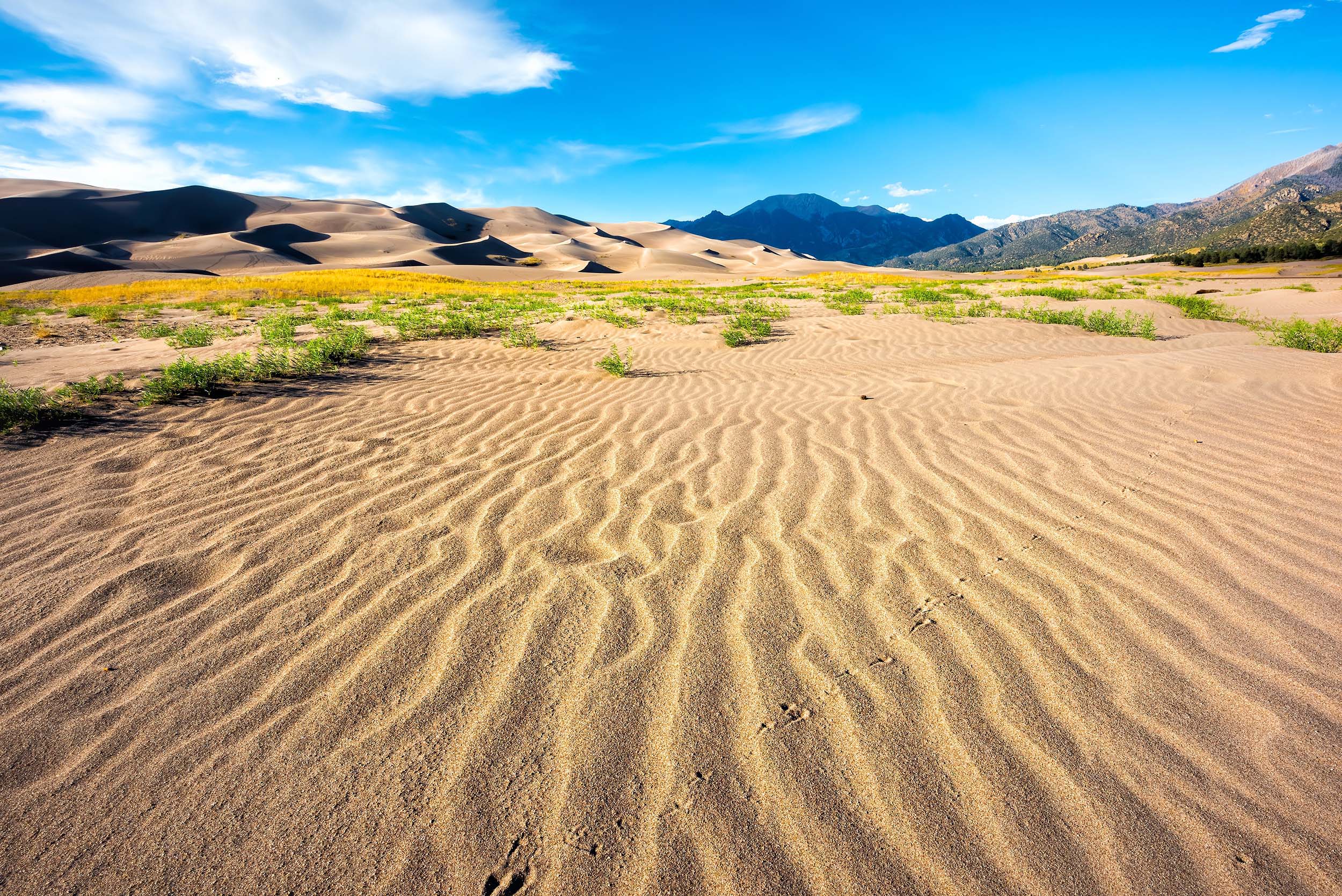
Gear We Used


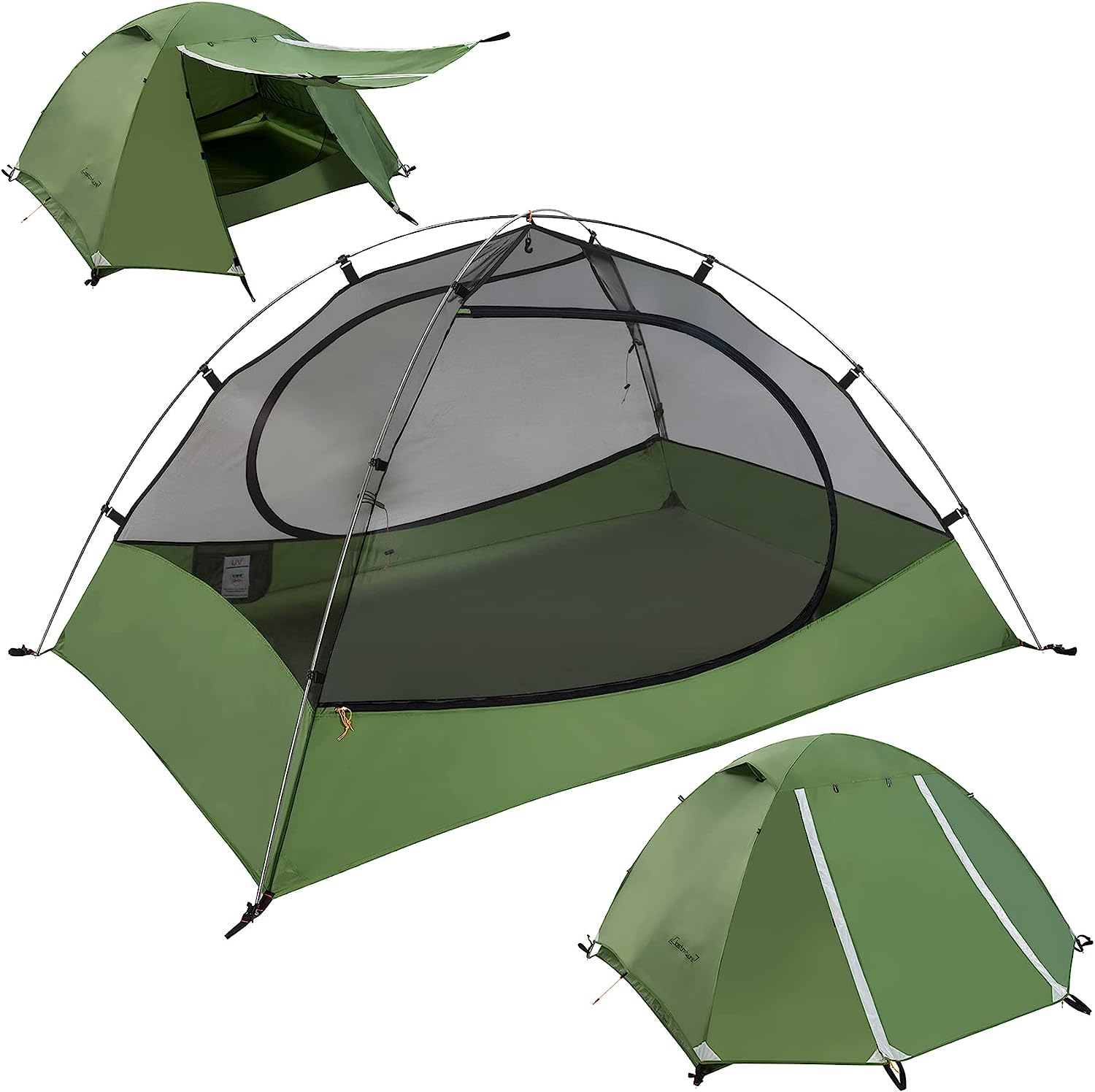

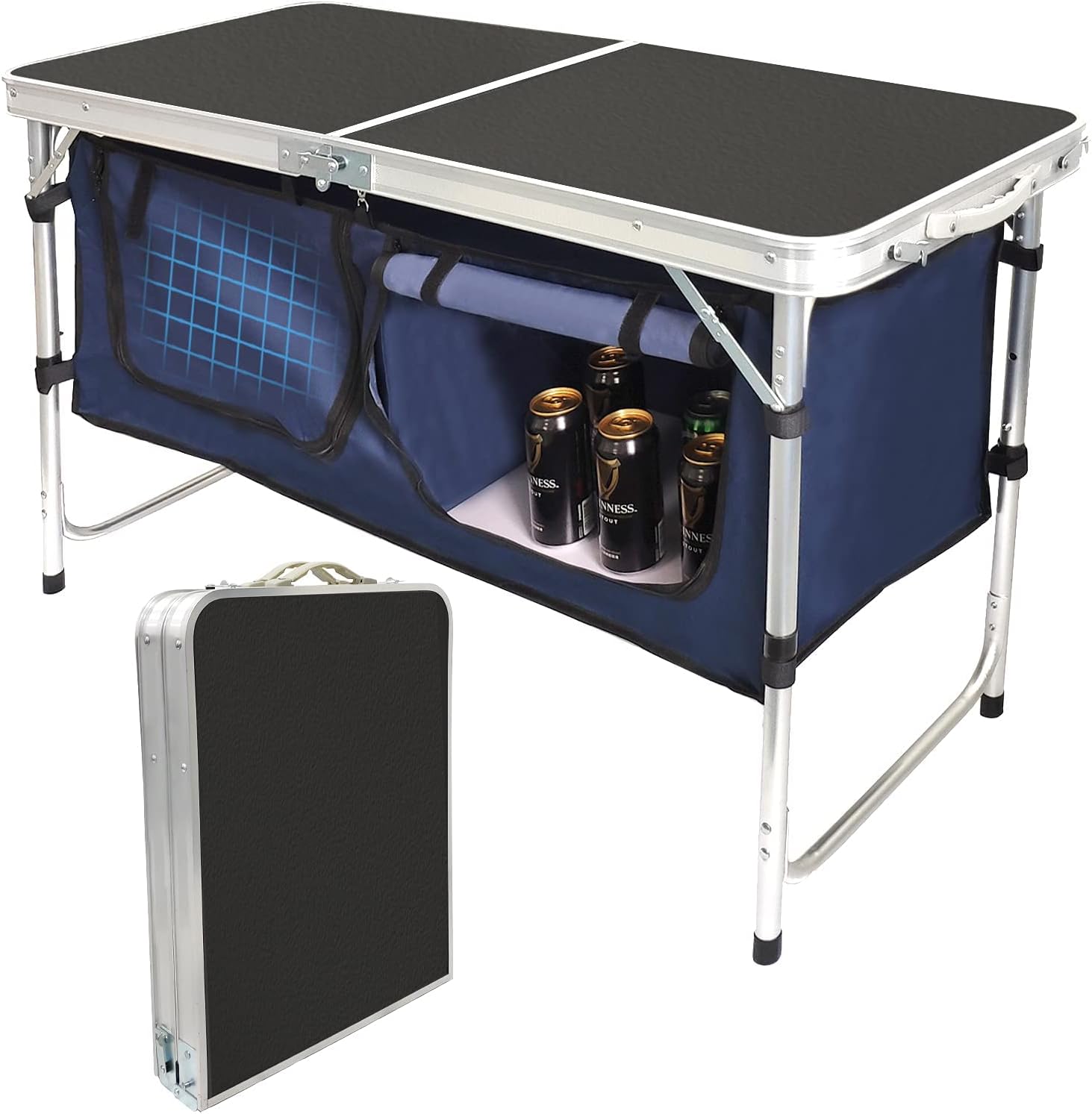
Must-Do Activities
Sandboarding and Sand Sledding
One of the most iconic activities at Great Sand Dunes National Park is sandboarding or sand sledding. The park’s massive dunes provide an ideal landscape for these thrilling sports. Visitors can rent boards or sleds from local vendors and ride down the soft, steep slopes of the dunes. This activity is especially popular during the cooler parts of the day, either early morning or late afternoon, to avoid the intense midday heat. It’s a fun and unique way to experience the dunes while enjoying some adrenaline!
Stargazing
Hike to High Dune
A hike to the top of High Dune is a must-do for visitors looking to take in breathtaking views of the park’s sand dunes and the surrounding San Luis Valley. The 3-mile round-trip trail can be physically challenging due to the soft sand, but the panoramic views at the summit are well worth the effort. From the top, you can see the expansive dune field, the Sangre de Cristo Mountains, and the distant valley below. It’s an unforgettable experience for those seeking a rewarding outdoor adventure.
Great Sand Dunes National Park History
The history of Great Sand Dunes National Park is deeply intertwined with the natural forces that shaped its stunning landscape. The park’s towering dunes, which rise as high as 750 feet, are the result of thousands of years of wind and water erosion. The sand is primarily derived from ancient lakes and volcanic eruptions that once covered the area. Over time, these materials were carried by prevailing winds and deposited in the valley, creating the vast sand dunes we see today. The dynamic nature of the dunes means they are constantly shifting, adding an element of mystery and awe to the landscape. These geological processes have been ongoing for at least 12,000 years, though the dunes themselves are much older.
The area has long been inhabited by indigenous peoples, who have left behind a rich cultural legacy. Archaeological evidence suggests that early Native American tribes, such as the Ute and Navajo, used the land for hunting, gathering, and ceremonial purposes. The park’s diverse ecosystems provided essential resources, from water in the wetlands to game in the surrounding hills. The significance of the dunes as a sacred place is still present in the oral traditions and spiritual practices of these indigenous cultures. The first European settlers to the region arrived in the 19th century, and the land became part of the United States’ westward expansion, with homesteaders and explorers passing through the area.





